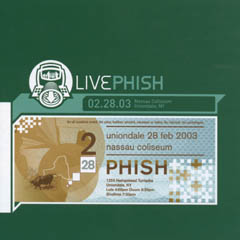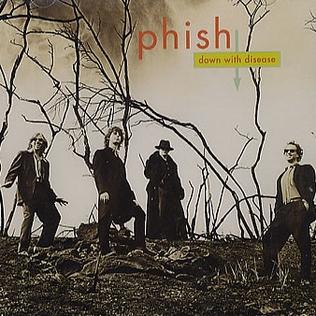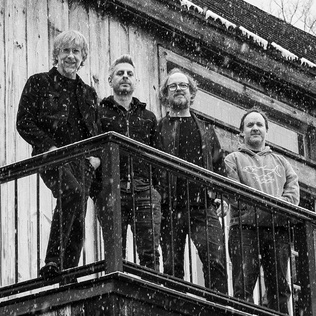Related Research Articles

Phish is an American rock band that formed in Burlington, Vermont, in 1983. The band is known for musical improvisation, extended jams, blending of genres, and a dedicated fan base. The band consists of guitarist Trey Anastasio, bassist Mike Gordon, drummer Jon Fishman, and keyboardist Page McConnell, all of whom perform vocals, with Anastasio being the primary lead vocalist.

Ernest Joseph "Trey" Anastasio III is an American guitarist, singer, and songwriter, best known as the lead guitarist of the rock band Phish, which he co-founded in 1983. He is credited by name as composer of 152 Phish original songs, 141 of them as a solo credit, in addition to 41 credits attributed to the band as a whole.

Hampton Comes Alive is a six-disc live album by the American rock band Phish, released on November 23, 1999, by Elektra Records. It is the band's third live album and the first time complete live Phish concerts were released in their entirety. Hampton Comes Alive consists of two full concerts recorded on November 20 and 21, 1998, at the Hampton Coliseum in Hampton, Virginia. The album title is a play on Peter Frampton's classic live album Frampton Comes Alive!.

Michael Eliot Gordon is an American bass guitarist and vocalist most recognized as a founding member of the band Phish. In addition to bass, Gordon is an accomplished banjo player, and is proficient at piano and guitar. He is also a filmmaker and author. He has released five solo studio albums and three studio albums with acoustic guitar pioneer Leo Kottke.

A Live One is a live album by the American rock band Phish, released on June 27, 1995, by Elektra Records. The album was the band's first official live release, their first album to be certified Platinum by the Recording Industry Association of America and one of the best-selling releases in their catalog.

The Story of the Ghost is the seventh studio album by American rock band Phish, released by Elektra Records on October 27, 1998. The album features an emphasis on the jazz-funk influenced "cow-funk" style, which the group had been experimenting with in concert throughout 1997 and 1998. The album's first single was "Birds of a Feather", which was a Top 20 hit on Billboard magazine's Adult Alternative Songs chart.
The Man Who Stepped into Yesterday is a 1987 concept album written by Trey Anastasio, the guitarist and lead vocalist of the American rock band Phish, as his senior thesis while attending Goddard College. Composed in 1987, the thesis included an essay piece and collection of songs relating an epic tale from the band's fictional land of Gamehendge.
70 Volt Parade was Trey Anastasio's backing band in 2005, formed after the breakup of Phish in August of the previous year. After writing and recording new material in late 2004 and early 2005, Anastasio began auditioning various musicians for his next project. This band essentially replaced Anastasio's first backup band that was together in different forms from 1999 to 2004. 70 Volt Parade originally included Peter Chwazik on bass, Skeeto Valdez on drums, Les Hall on guitar and keyboards, and Ray Paczkowski also on keyboards. In 2006, with Les Hall out of the lineup, and a new musical focus for Anastasio, the 70 Volt Parade name was dropped.
Gamehendge is the fictional setting for a number of songs by the rock band Phish. Most of the songs can be traced back to The Man Who Stepped Into Yesterday, the senior project of guitarist and primary vocalist Trey Anastasio, written while he attended Goddard College in 1987. The recording of TMWSIY has been heavily circulated among fans and is considered by some to be an unreleased Phish album. Outside of the songs from TMWSIY, there are numerous other songs set in the fictional universe of Gamehendge.
Phish is an American rock band formed in 1983, dissolved in 2004, and reunited in 2009. It is one of the most successful live acts in popular music history, forging a popularity in concert far greater than their album sales, radio airplay, or music video presence would otherwise indicate. Phish, at the peak of their popularity in the mid- to late 1990s, consistently ranked as one of the highest-grossing concert tours in the world.

"Birds of a Feather" is a 1998 song by the American band Phish. It is the second track from their 1998 album The Story of the Ghost and was released as their twelfth promotional single by Elektra Records. The song is a funk rock song written by the entire band and lyricist Tom Marshall, and was influenced by Talking Heads.

Live Phish Vol. 2 was recorded live on July 16, 1994 and was released on September 18, 2001 as part of the Live Phish Series. The show was performed on the side of a ski slope at the Sugarbush Resort in the town of North Fayston, located in Phish's home state of Vermont. It was the final concert of the band's highly successful 1994 summer tour. Earlier in the year, the band had released its highest selling album to date (Hoist) and the size of the Phish audience had expanded greatly by the summer. The Sugarbush concert, which included overnight camping on the ski slope under the stars, was slated as the grand finale of the tour.

Live Phish Vol. 1 was recorded live at the Broome County Veterans Memorial Arena in Binghamton, New York on December 14, 1995. The show occurred towards the end of the band's 1995 fall tour, which featured a tour-long chess game between Phish and its audience. The second disc begins with a fan making a chess move onstage on behalf of the audience.

Live Phish Vol. 3 was recorded live at the Darien Lake Performing Arts Center in Darien, New York, on September 14, 2000. The show was part of the band's final tour before taking an indefinite extended hiatus three weeks later.

Live Phish Vol. 9 was recorded live at the Townshend Family Park in Townshend, Vermont on August 26, 1989.

Live Phish 2-28-03 was recorded February 28, 2003 at the Nassau Coliseum in Uniondale, New York.

Live Phish 04.04.98 is the third night of the four-night "Island Tour", recorded live at the Providence Civic Center in Providence, Rhode Island, on April 4, 1998.

"Down with Disease" is a 1994 song by American band Phish. It is the second track from their 1994 album Hoist and was released as their fifth promotional single by Elektra Records. The song is a funk rock song written by Phish guitarist and lead vocalist Trey Anastasio and lyricist Tom Marshall. The song's lyrics were based on a bout with infectious mononucleosis suffered by Marshall.
"Cavern" is a 1992 song by the American band Phish. It is the third track from their 1992 album A Picture of Nectar and was also released as their second promotional single by Elektra Records. The song is a beat-driven funk rock song written by Phish guitarist and lead vocalist Trey Anastasio and lyricist Scott Herman and Tom Marshall.
“Cavern” has been a rock in Phish’s rotation since early 1990. While most fans have become accustomed to the song as a set-closer or encore, initially it was much more versatile, appearing just about everywhere in the setlist. It was only beginning in 1992 that the band began utilizing it in its current role. In fact, beginning in fall 1992, well over half of the performances of “Cavern” have come either at the close of a set or during an encore. And no wonder: the song’s straight-up rock feel and fist-pumping climax make it a fitting exclamation point on the end of an evening of more excursionary jamming.

Sigma Oasis is the fifteenth studio album by the American rock band Phish, released on the band's JEMP Records label on April 2, 2020. The album was recorded at their studio The Barn and was produced by the band and Vance Powell.
References
- ↑ "Harry Hood History".
- ↑ "Personal Stats".
- ↑ Puterbaugh, Parke. "Phish: The Biography". Da Capo Press, 2009, p. 48.